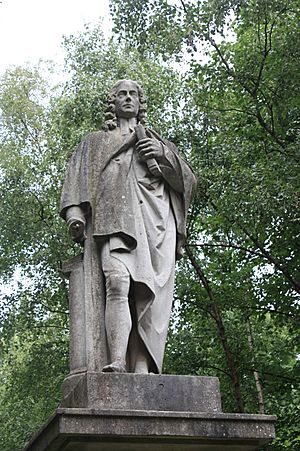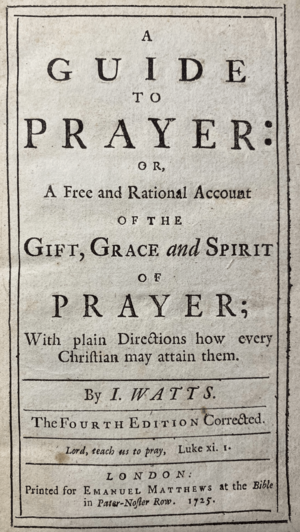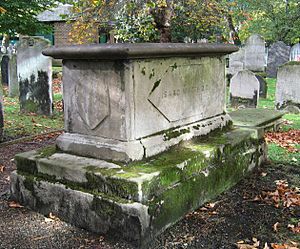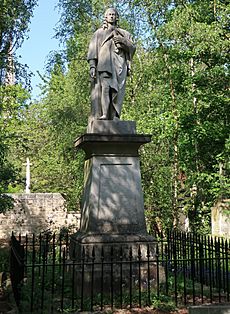Isaac Watts facts for kids
Quick facts for kids
Isaac Watts
|
|
|---|---|

Portrait by an unknown artist
|
|
| Born | 17 July 1674 Southampton, Hampshire, England
|
| Died | 25 November 1748 (aged 74) Stoke Newington, Middlesex, England
|
| Occupation | Hymnwriter, theologian |
| Known for | "When I Survey the Wondrous Cross", "Joy to the World", "Our God, Our Help in Ages Past" |
Isaac Watts (born 17 July 1674 – died 25 November 1748) was an English minister, writer of hymns, and thinker. He wrote around 750 hymns, making him very popular. Some of his most famous hymns include "When I Survey the Wondrous Cross", "Joy to the World", and "Our God, Our Help in Ages Past". He is often called the "Godfather of English Hymnody" because his hymns are still sung today and have been translated into many languages.
Contents
Isaac Watts' Life Story
Isaac Watts was born in Southampton, England, in 1674. His family were Nonconformists, meaning they did not follow the official Church of England. His father was even put in prison twice for his religious beliefs.
Isaac went to King Edward VI School, Southampton, where he learned Latin, Greek, and Hebrew. He showed a talent for writing poems and rhymes from a young age.
Because he was a Nonconformist, Isaac could not go to famous universities like Oxford or Cambridge. These universities were only for people who belonged to the Church of England. Instead, he went to a special school for Nonconformists called the Dissenting Academy in Stoke Newington in 1690. He spent most of his life in this area, which is now part of Inner London.
After his studies, Watts became a pastor at a large church in London, even though he had poor health. He believed in bringing different Christian groups together, which was unusual for his time. He was more interested in promoting education and learning than in focusing on one specific religious group.
Watts later worked as a private teacher and lived with the Hartopp family, who were also Nonconformists. Through them, he met their neighbors, Sir Thomas Abney and Lady Mary. He ended up living with the Abney family for 36 years, mostly at their home, Abney House.
Lady Mary Abney inherited the land around Stoke Newington in 1701. After her husband died in 1722, she invited Watts to continue living with them at Abney House. Watts loved the gardens at Abney Park, which Lady Mary had designed. He often found inspiration there for the many books and hymns he wrote.
Isaac Watts lived at Abney Hall until he died in 1748. He was buried in Bunhill Fields. He left behind many hymns, books, and essays that greatly influenced religious leaders in the 1700s.
Isaac Watts' Hymns
Isaac Watts changed how people sang in church. Before him, many churches mainly sang Psalms, which are ancient songs from the Bible. Watts believed that Christians should also sing "original songs of Christian experience" that spoke about their faith in new ways.
Watts also wrote new versions of the Psalms for church services. He wanted them to have a Christian meaning, as he explained in his 1719 book of Psalms. He said the Psalms should be "imitated in the language of the New Testament." This meant he would add ideas about Jesus and the Gospel to the old Psalms.
For example, if a Psalm talked about God's mercy, Watts would add how that mercy comes through Jesus. If it mentioned animal sacrifices, he would talk about Jesus's sacrifice. This helped people see how the Old Testament connected to the New Testament.
Watts' book Hymns and Spiritual Songs, first published in 1707, is seen by many as the start of hymns being widely used in English churches. His beautiful writing and his way of connecting old scriptures with new Christian understanding made his hymns very popular. Many of his hymns are still sung today.
Watts' Logic Book
Isaac Watts also wrote a very popular textbook about logic, which is the study of correct reasoning. Its full title was Logick, or The Right Use of Reason in the Enquiry After Truth With a Variety of Rules to Guard Against Error in the Affairs of Religion and Human Life, as well as in the Sciences. This book was first published in 1724 and was printed twenty times!
Watts wrote this book for people who were just starting to learn about logic. He organized it very clearly into four main parts: how we understand things (perception), how we make decisions (judgement), how we think things through (reasoning), and how we organize our thoughts (method).
Watts' Logic was different from other books of its time. It was influenced by thinkers like John Locke. Watts made sure to explain the difference between a "judgement" (an idea in your mind) and a "proposition" (that idea put into words).
He also focused on the practical side of logic. He believed logic was an "art" that could help people in any kind of study, whether it was science, art, or even deciding what is right or wrong. This focus on practical use made his book stand out.
Watts' Logic became the standard textbook for logic at top universities like Oxford, Cambridge, Harvard, and Yale. It was used at Oxford for over 100 years! Even a famous logician from the 1800s, Charles Sanders Peirce, praised Watts' book.
In 1741, Watts wrote a follow-up book called The Improvement of the Mind. This book also became very popular and was used as a moral textbook in schools. It even inspired the famous scientist Michael Faraday.
Legacy and Memorials
After Isaac Watts died, his writings were given to Yale University in America. The King Edward VI School, Southampton, where he studied, named one of its school houses "Watts" in his honor.
The Church of England and Lutheran Church remember Isaac Watts every year on 25 November.
The oldest monument to Watts is in Westminster Abbey, built soon after he died. His tomb in Bunhill Fields was built in 1808, replacing the first one paid for by Lady Mary Abney and the Hartopp family.
The first public statue of Isaac Watts stands in Abney Park, where he lived for over 30 years. This park later became Abney Park Cemetery. The statue was put there in 1845, paid for by public donations. It was designed by a famous sculptor, Edward Hodges Baily.
Another similar statue was built in a new park named after Watts in Southampton, his hometown. In the mid-1800s, a church hall in Southampton was also named the Dr Watts Memorial Hall. Even though that building was destroyed in World War II, a new church, the Isaac Watts Memorial United Reformed Church, was built on the same spot.
In 1974, the city of Southampton celebrated 300 years since Watts' birth. They asked David G. Fountain, a minister from Southampton like Watts, to write a book about him called Isaac Watts Remembered.

Watts' Influence in Culture
Isaac Watts' writings have appeared in many famous books and stories:
- In his novel David Copperfield (1850), author Charles Dickens has a school master quote from Watts' poem "Against Idleness and Mischief".
- In Herman Melville's novel Moby-Dick (1851), a character named Charity Bildad gives sailors copies of Watts' hymns to sing instead of "profane songs."
One of Watts' most famous poems was "Against Idleness and Mischief" from his book Divine Songs for Children. This poem was famously made fun of by Lewis Carroll in his poem "How Doth the Little Crocodile", which is in Chapter 2 of Alice's Adventures in Wonderland (1865). Carroll's parody is now more famous than Watts' original poem! Another poem by Watts, "The Sluggard", was also parodied in Alice's Adventures in Wonderland as "'Tis the Voice of the Lobster".
In the 1884 comic opera Princess Ida, there's a joke about Watts. In a women's university where no men are allowed, the king says that the princess "She'll scarcely suffer Dr. Watts' 'hymns'".
A poem often linked to Joseph Merrick ("The Elephant Man") that starts "Tis true, my form is something odd/but blaming me, is blaming God..." is sometimes wrongly said to be by Isaac Watts. Only the last few lines of that poem were actually written by Watts.
Works by Isaac Watts
Books
- Hymns and Spiritual Songs (1707)
- Horae Lyricae: Poems, Chiefly of the Lyric Kind (1709)
- Divine Songs Attempted in Easy Language for the Use of Children (1715)
- Guide to Prayer (1715)
- Psalms of David: Imitated in the Language of the New Testament, and Apply'd to the Christian State and Worship (1719)
- Logick: or, the Right use of Reason in the Enquiry After Truth (1726)
- The Improvement of the Mind (1741)
- The Knowledge of the Heavens and the Earth Made Easy (1726)
Famous Hymns
Some of Isaac Watts' well-known hymns include:
- "Joy to the World" (based on Psalm 98)
- "Come ye that Love the Lord" (often called "We’re marching to Zion")
- "Come Holy Spirit, Heavenly Dove"
- "Jesus Shall Reign Where’er the Sun" (based on Psalm 72)
- "Our God, Our Help in Ages Past" (based on Psalm 90)
- "When I Survey the Wondrous Cross"
- "Alas! and Did My Saviour Bleed"
- "How Sweet and Awful Is the Place"
- "This Is the Day the Lord Hath Made"
- "When I Can Read My Title Clear"
- "I Sing the Mighty Power of God" (from Divine Songs Attempted in Easy Language for the Use of Children)
- "My Shepherd Will Supply My Need" (based on Psalm 23)
- "Bless, O My Soul! the Living God" (based on Psalm 103)
Many of Watts' hymns are still used in hymnals (songbooks) by various Christian churches around the world today.
Images for kids
See also
 In Spanish: Isaac Watts para niños
In Spanish: Isaac Watts para niños
- Congregational church
- English Dissenter
- Independent (religion)
- Puritan








